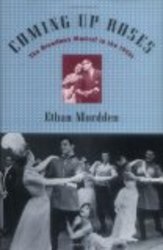Description
This book looks at the decade of the 1950s and how Broadway musicals changed during that time. Ethan Mordden discusses how George Abbott was a good director but not a visionary and how Guys and Dolls and My Fair Lady were important for the development of the musical. He also discusses Lenny Bernstein's Candide which was the "uniquely influential title" of the decade.
A lively look at Broadway's most exciting decade, "Coming Up Roses" celebrates the explosion of musicals that hit the American stage in the 1950s.
This book begins its survey of a seminal decade in American theater in 1950, when the Broadway musical method in which stars like Ethel Merman slogged it out show after show, formula after formula, success after success had run its course, sparking the need for innovation. It ends in 1959, after a decade of innovation had raised the musical to new heights--heights that the genre would not maintain in later decades. In between, Ethan Mordden paints a picture of the musical that is warm and sympathetic, even as it pours cold water on what the author considers the medium's excesses and failures. Mordden isn't shy about sharing his opinions. He links the legendary director George Abbott to the stagnation that set in during the early '50s: "He was a journeyman, not a visionary. He was very, very good at what he knew how to do, and, like all conservatives, never attempted to do anything else." Regarding
Can Can he writes, "Clearly, what saved it at first was the score and the production; at length, its dippy book destroyed it." And, at odds with the millions who revere
The Sound of Music, Mordden acknowledges its "slight but extremely tuneful score," concluding that the show has a "somewhat disappointing position in the Rodgers and Hammerstein canon." Mordden praises
Guys and Dolls--"a classic" and
My Fair Lady--"it's culturally imperative ... capitalism at its best." Lenny Bernstein's
Candide is the "uniquely influential title" of the 1950s, "perhaps the last crucial revolutionary development in the musical's history." All this praise is lovingly spelled out in chapters that dwell on the productions themselves in a chunky narrative cluttered with an insider's look behind the scenes. Mordden's book forces readers to rethink much of what they know about the Broadway musical and to listen, and listen again, to their favorite soundtracks.
--Roy Wadia











